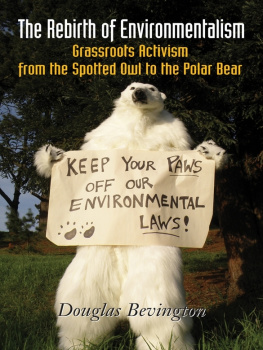The National Environmental Policy Act slightly predated the first Earth Day, having been signed by President Nixon in January 1970. It received little debate in Congress and passed by overwhelming majorities in both the House and Senate. This is arguably the most wide-reaching piece of federal environmental legislation. In addition to creating the Council of Environmental Quality within the executive branch, it established the requirement of an environmental impact statement for every major federal project. As part of the environmental impact statement, federal agencies must assess the environmental consequences of their proposed actions and consider a range of alternatives. This process provides substantially increased opportunities for public participation in agency policy making, both by creating a detailed public record of environmental impacts and also by providing for increased public input and oversight. Thus the National Environmental Protection Act became the foundation for much of the environmental litigation against federal agencies. Environmental scholar Robert Gottlieb described this legislation as the cornerstone of contemporary environmental policies, but noted that it was enacted with little input from any of the mainstream [environmental] groups who eventually constituted the Group of Ten.
Marine Mammal Protection Act
The Marine Mammal Protection Act became law in the 1972. It reflected a high level of public interest in the welfare of whales and dolphins. One key impetus for the Marine Mammal Protection Act was the revelation that hundreds of thousands of dolphins were being killed each year by the U.S. tuna fishing fleet in the Eastern Tropical Pacific. There the fishers would deliberately encircle dolphins in nets because large schools of tuna were often found swimming with the dolphins. Although the fishery did not seek to harvest the dolphins, many were killed when they became entangled in the nets and drowned. It was estimated that about 5 million dolphins were killed this way in the late 1950s and 1960s.
In response, a bill called the Ocean Mammal Protection Act was introduced in Congress in 1971. The prospective legislation was notable for its comprehensive ban on the killing of marine mammals and the importation of marine mammal products. At first the bill attracted significant political momentum, but then it ran into opposition from a coalition of conservation groups representing wildlife managers, including the National Audubon Society and the World Wildlife Fund. Wildlife managers objected to the comprehensive moratorium, which was seen as divergent from the maximum sustained yield approach that had dominated wildlife management up until that time. The coalition succeeded in derailing the Ocean Mammal Protection Act and replacing it with a less restrictive bill called the Ocean Mammal Management Act, which sought to manage marine mammals within a sustained yield approach, while exempting the tuna fleet from these regulations. This bill was poised to be passed by the House of Representatives in December 1971 when a last minute flurry of media outreach by Friends of Animalsa small animal rights organization with one person on staff in DCled to Washington Post and New York Times editorials against the Ocean Mammal Management Act. The bill was subsequently defeated.
Then in 1972, the Marine Mammal Protection Act was introduced as a compromise bill, combining elements of both the Ocean Mammal Protection Act and the Ocean Mammal Management Act. It became law by the end of the year. The Marine Mammal Protection Act returned to a moratorium approach, but included various exemptions, including a provision allowing for a long phase-out period for the dolphin bycatch of the tuna fleet. As a result, tens of thousands of dolphins continued to be killed by U.S. fishers each year through the 1970s and 1980s. Thus in the case of the Marine Mammal Protection Act, two of the national environmental organizations (National Audubon Society and World Wildlife Fund) played a counterproductive role that led to a weakening of biodiversity protection compared to the original legislation. Moreover, the much more problematic legislation originally promoted by those two organizations was defeated by a small animal rights group, Friends of Animals, rather than any of the established national environmental organizations.
Endangered Species Act
The Endangered Species Act of 1973 is the most powerful biodiversity protection law in the United States. Indeed it has been described as the most far-reaching wildlife statute ever adopted by any nation. The new legislation faced no notable opposition in Congress or from industry. No commercial interests testified against the bill as it was proceeding through congressional hearings. It moved quickly through Congress and was passed with unanimous support in the Senate and only twelve votes against it in the House of Representatives.
Yet unlike the much earlier case of the Wilderness Act where the role of groups such as the Sierra Club and The Wilderness Society was clearly evident (see chapter 2), one is hard pressed to find evidence of the national environmental organizations playing a significant role in the passage of the Endangered Species Act. Indeed, in policy analyst Steven Yaffees account of the legislative history, the groups that he listed as being directly involved in lobbying for a strong endangered species law were animal rights groups and relatively minor environmental groupsthe Fund for Animals, the Society for Animal Protective Legislation, the National Parks and Conservation Association, and the Committee for the Preservation of Tule Elkrather than the dominant national environmental organizations. (For a more detailed discussion of the provisions of the Endangered Species Act and a history of the subsequent amendments, see chapter 5.)
National Forest Management Act
The National Forest Management Act of 1976 provided increased opportunities for public oversight of the Forest Service. It would become a key tool of forest protection activists and ultimately was the legal cornerstone for Judge William Dwyers sweeping injunctions against logging on national forests in the Pacific Northwest in 1989 and 1991 (see chapter 4). However, those later successes stood in contrast to the National Forest Management Acts troubled origins. Unlike with the Endangered Species Act, the involvement of national environmental organizations was readily apparent in the legislative history of the National Forest Management Act, but the effect of their involvement was problematic.












